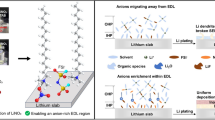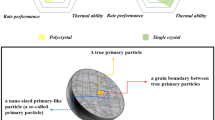Abstract
Lithium-rich layered oxide (LLO) cathode materials have drawn extensive attention due to their ultrahigh specific capacity and energy density. However, their commercialization is still restricted by their low initial coulombic efficiency, slow intrinsic kinetics and structural instability. Herein, a facile surface treatment strategy via gaseous phosphine was designed to improve the rate performance and capacity stability of LLOs. During the solid-gas reaction, phosphine reacted with active oxygen at the surface of LLOs due to its reductivity, forming oxygen vacancies and spinel phase at the surface region. As a result, Li ion conductivity and structural stability were greatly enhanced. The phosphinetreated LLOs (LLO@P) showed a layered-spinel hybrid structure and delivered an outstanding rate performance of 156.7 mA h g−1 at 10 C and a high capacity retention of 74% after 300 cycles at 5 C.
摘要
富锂材料具有较高的比容量和能量密度, 因而受到了广泛关 注. 但是富锂材料仍然面临着库伦效率低、动力学性能差以及结 构稳定性差等缺点, 限制了其进一步的商业化应用. 本文中通过气 相的磷化氢对富锂材料进行热处理, 来提高其倍率性能和循环稳 定性. 在热处理过程中, 具有较高还原活性的磷化氢会与富锂材料 的表面活性氧原子进行反应, 进而在材料表面生成氧空穴和尖晶 石相结构. 改性后, 富锂材料的锂离子电导率和结构稳定性显著提 升, 当以1 0 C的大电流进行充放电时, 放电比容量可达 156.7 mA h g−1, 在5 C下循环300圈后容量保持率仍然可达74%.
Similar content being viewed by others
References
Sun Z, Xu L, Dong C, et al. A facile gaseous sulfur treatment strategy for Li-rich and Ni-rich cathode materials with high cycling and rate performance. Nano Energy, 2019, 63: 103887–103893
Lee J, Kitchaev DA, Kwon DH, et al. Reversible Mn2+/Mn4+ double redox in lithium-excess cathode materials. Nature, 2018, 556: 185–190
Zhang XD, Shi JL, Liang JY, et al. Suppressing surface lattice oxygen release of li-rich cathode materials via heterostructured spinel Li4Mn5O12 coating. Adv Mater, 2018, 30: 1801751
Wang J, Sun X. Olivine LiFePO4: the remaining challenges for future energy storage. Energy Environ Sci, 2015, 8: 1110–1138
Sui D, Xu L, Zhang H, et al. A 3D cross-linked graphene-based honeycomb carbon composite with excellent confinement effect of organic cathode material for lithium-ion batteries. Carbon, 2019, 157: 656–662
Yu FD, Que LF, Xu CY, et al. Dual conductive surface engineering of Li-rich oxides cathode for superior high-energy-density Li-ion batteries. Nano Energy, 2019, 59: 527–536
Sun Z, Xu L, Dong C, et al. Enhanced cycling stability of boron-doped lithium-rich layered oxide cathode materials by suppressing transition metal migration. J Mater Chem A, 2019, 7: 3375–3383
Zhao E, Yu X, Wang F, et al. High-capacity lithium-rich cathode oxides with multivalent cationic and anionic redox reactions for lithium ion batteries. Sci China Chem, 2017, 60: 1483–1493
Yi L, Liu Z, Yu R, et al. Li-rich layered/spinel heterostructured special morphology cathode material with high rate capability for Li-ion batteries. ACS Sustain Chem Eng, 2017, 5: 11005–11015
Ma Y, Liu P, Xie Q, et al. Double-shell Li-rich layered oxide hollow microspheres with sandwich-like carbon@spinel@layered@spinel@carbon shells as high-rate lithium ion battery cathode. Nano Energy, 2019, 59: 184–196
Zheng J, Xu P, Gu M, et al. Structural and chemical evolution of Li- and Mn-rich layered cathode material. Chem Mater, 2015, 27: 1381–1390
Zhang S, Chen J, Tang T, et al. A novel strategy to significantly enhance the initial voltage and suppress voltage fading of a Li- and Mn-rich layered oxide cathode material for lithium-ion batteries. J Mater Chem A, 2018, 6: 3610–3624
Zheng J, Myeong S, Cho W, et al. Li- and Mn-rich cathode materials: Challenges to commercialization. Adv Energy Mater, 2017, 7: 1601284
Yi TF, Han X, Yang SY, et al. Enhanced electrochemical performance of Li-rich low-Co Li1.2Mn0.56Ni0.16Co0.08−xAlxO2 (0≤x≤0.08) as cathode materials. Sci China Mater, 2016, 59: 618–628
Nayak PK, Erickson EM, Schipper F, et al. Review on challenges and recent advances in the electrochemical performance of high capacity Li- and Mn-rich cathode materials for Li-ion batteries. Adv Energy Mater, 2017, 8: 1702397
Fu Q, Du F, Bian X, et al. Electrochemical performance and thermal stability of Li1.18Co0.15Ni0.15Mn0.52O2 surface coated with the ionic conductor Li3VO4. J Mater Chem A, 2014, 2: 7555–7562
Wang J, He X, Paillard E, et al. Lithium- and manganese-rich oxide cathode materials for high-energy lithium ion batteries. Adv Energy Mater, 2016, 6: 1600906
Lu Z, Dahn JR. Structure and electrochemistry of layered Li[CrxLi(1/3−x/3)Mn(2/3−2x/3)]O2. J Electrochem Soc, 2002, 149: A1454
Cai Y, Ku L, Wang L, et al. Engineering oxygen vacancies in hierarchically Li-rich layered oxide porous microspheres for highrate lithium ion battery cathode. Sci China Mater, 2019, 62: 1374–1384
Erickson EM, Sclar H, Schipper F, et al. High-temperature treatment of Li-rich cathode materials with ammonia: improved capacity and mean voltage stability during cycling. Adv Energy Mater, 2017, 7: 1700708
Hy S, Felix F, Rick J, et al. Direct In situ observation of Li2O evolution on Li-rich high-capacity cathode material, Li[NixLi(1−2x)/3Mn(2−x)/3]O2 (0 ≤ x ≤0.5). J Am Chem Soc, 2014, 136: 999–1007
Qiu B, Zhang M, Wu L, et al. Gas-solid interfacial modification of oxygen activity in layered oxide cathodes for lithium-ion batteries. Nat Commun, 2016, 7: 12108
Han S, Qiu B, Wei Z, et al. Surface structural conversion and electrochemical enhancement by heat treatment of chemical predelithiation processed lithium-rich layered cathode material. J Power Sources, 2014, 268: 683–691
Shi S, Wang T, Cao M, et al. Rapid self-assembly spherical Li1.2Mn0.56Ni0.16 Co0.08O2 with improved performances by microwave hydrothermal method as cathode for lithium-ion batteries. ACS Appl Mater Interfaces, 2016, 8: 11476–11487
Park S, Kang S, Johnson C, et al. Lithium-manganese-nickel-oxide electrodes with integrated layered-spinel structures for lithium batteries. Electrochem Commun, 2007, 9: 262–268
Zhang X, Yu R, Huang Y, et al. The influences of surface coating layers on the properties of layered/spinel heterostructured Li-rich cathode material. ACS Sustain Chem Eng, 2018, 6: 12969–12979
Wu B, Yang X, Jiang X, et al. Synchronous tailoring surface structure and chemical composition of Li-rich-layered oxide for high-energy lithium-ion batteries. Adv Funct Mater, 2018, 28: 1803392
Ku L, Cai Y, Ma Y, et al. Enhanced electrochemical performances of layered-spinel heterostructured lithium-rich Li1.2Ni0.13Co0.13-Mn0.54O2 cathode materials. Chem Eng J, 2019, 370: 499–507
Xia Q, Zhao X, Xu M, et al. A Li-rich layered@spinel@carbon heterostructured cathode material for high capacity and high rate lithium-ion batteries fabricated via an in situ synchronous carbonization-reduction method. J Mater Chem A, 2015, 3: 3995–4003
Zheng Y, Chen L, Su Y, et al. An interfacial framework for breaking through the Li-ion transport barrier of Li-rich layered cathode materials. J Mater Chem A, 2017, 5: 24292–24298
Julien CM, Massot M. Lattice vibrations of materials for lithium rechargeable batteries III. Lithium manganese oxides. Mater Sci Eng-B, 2003, 100: 69–78
Meng F, Guo H, Wang Z, et al. Modification by simultaneously γ-WO3/Li2WO4 composite coating and spinel-structure formation on Li[Li0.2Mn0.54Ni0.13Co0.13]O2 cathode via a simple wet process. Alloys Compd, 2019, 790: 421–432
Niu B, Li J, Liu Y, et al. Re-understanding the function mechanism of surface coating: modified Li-rich layered Li1.2Mn0.54Ni0.13Co0.13O2 cathodes with YF3 for high performance lithium-ions batteries. Ceramics Int, 2019, 45: 12484–12494
Acknowledgements
The authors gratefully acknowledge the financial support from the Ministry of Science and Technology of China (MoST, 2016YFA0200200), the National Natural Science Foundation of China (NSFC, 21421001 and 51633002), Tianjin city (16ZXCLGX00100) and 111 Project (B12015).
Author information
Authors and Affiliations
Contributions
Chen Y conceived and designed the research; Xu L fabricated the cathode materials and assembled the cells; Sun Z conducted partial characterization and analyses; Zhu Y, Han Y, Wu M, Ma Y and Huang Y were involved in some experiments; Xu L and Zhang H wrote the paper, with support from Chen Y; Chen Y and Zhang H coordinated the study. All authors contributed to the general discussion.
Corresponding authors
Additional information
Conflict of interest
The authors declare that they have no conflict of interest.
Supplementary information
Experimental details and supporting data are available in the online version of the paper.
Lingqun Xu received her BS degree in polymer material and engineering from Yanshan University Now as a postgraduate in Nankai University, her research mainly focuses on improving the electrochemical performances of lithium-rich cathode materials and lithium sulfur batteries
Zhenhe Sun received his BE and BS degrees from the Molecular Science and Engineering department of Nankai University in 2015. He is currently studying for a doctoral degree in Prof. Yongsheng Chen’s Group. His research interests include the syntheses and modifications of lithium-rich cathode materials and supercapacitors based on carbon materials.
Hongtao Zhang received his PhD degree from the Institute of Chemistry, Chinese Academy of Sciences (ICCAS) in 2012. He joined Prof. Yongsheng Chen’s group at Nankai University in 2014. His current research interests mainly focus on the syntheses and characterizations of organic and polymer functional materials and their applications in energy conversion and storage devices.
Yongsheng Chen graduated from the University of Victoria with a PhD degree in chemistry in 1997 and then joined the University of Kentucky and the University of California at Los Angeles for postdoctoral studies from 1997 to 1999. From 2003, he has been a Chair Professor at Nankai University. His main research interests include: i) carbon-based nanomaterials, including carbon nanotubes and graphene; ii) organic and polymeric functional materials, and iii) energy devices including organic photovoltaics and supercapacitors.
Supporting Information
40843_2020_1433_MOESM1_ESM.pdf
A Li-rich layered-spinel cathode material for high capacity and high rate lithium-ion batteries fabricated via a gas-solid reaction
Rights and permissions
About this article
Cite this article
Xu, L., Sun, Z., Zhu, Y. et al. A Li-rich layered-spinel cathode material for high capacity and high rate lithium-ion batteries fabricated via a gas-solid reaction. Sci. China Mater. 63, 2435–2442 (2020). https://doi.org/10.1007/s40843-020-1433-4
Received:
Accepted:
Published:
Issue Date:
DOI: https://doi.org/10.1007/s40843-020-1433-4




